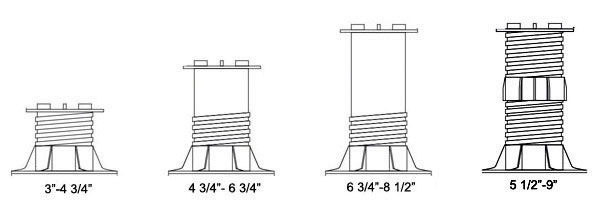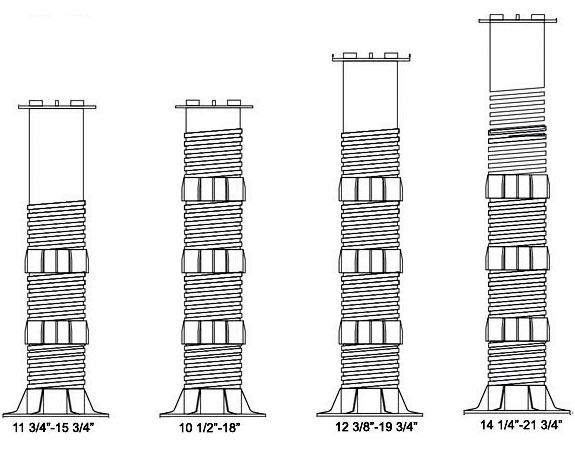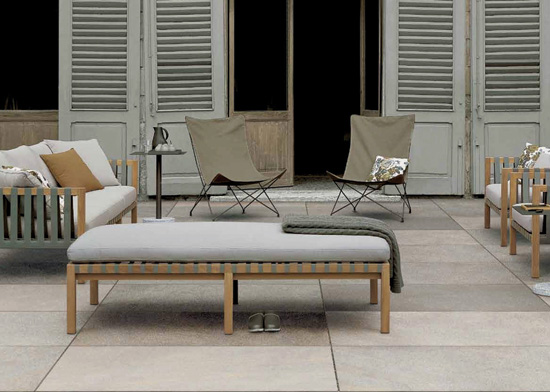A New Option in Exterior Paving
Types of Pedestal Systems
There are several basic types of pedestal systems available at present, both imported and domestically manufactured.
Polystyrene Blocks
The simplest type of pedestal system uses polystyrene foam blocks underneath the pavers. Manufacturers claim that these blocks can be used up to any height, load or steepness of substrate. The blocks are cut once the pedestals are in place via a hot-wire trolley riding on a laser-leveled track which trims off excess material above the bottom-of-paver elevation. Architects specifying this type of system should be clear about how the laser level track works and whether it must be purchased or can be leased from the pedestal manufacturer.
Pre-cut PVC Pipe System
In this system, lengths of PVC pipe are cut to the exact height required. One end of the pipe is slid onto a circular base component and the other onto a head component which incorporates spacer tabs. The disadvantage of this system is that the PVC pipe must be cut precisely to fit the elevation required as the only option for adjusting the height if the cut section is found to be even slightly inaccurate after placing under the pavers, is to build up the height with stackable rubber or EPDM shims placed between the paver and the pedestal head. Of course, if the PVC pipe is cut too long, the pipe must be removed and re-cut to the correct length.




Source:Eterno Ivica S.r.l.
Typical pedestal heights.
PVC Pipe With Adjustable Height Component
This system is similar to the precut PVC pipe system except that the head component incorporates a screwable column which provides a degree of height adjustment without requiring stacked shims and overcomes the necessity to cut the PVC pipe to a very precise dimension.
Fixed Height Deck Supports
These systems are typically used when laying pavers directly over an existing concrete surface, where the height of the elevated deck must be as low as possible or at the low side of a sloping surface before adjustable height pedestals can be used. Typically, fixed height supports are used for heights up to about 1 ½ inches.
Most fixed height supports are constructed of either plastic, rubber or ethylene propylene diene monomer (EPDM) and measure around 1/2 or ¾ inches high. They incorporate spacer tabs which may be snapped off or cut off as required. These supports can generally be stacked on top of each other for extra height. Rubber or EPDM supports offer an acoustic advantage over plastic supports, as they absorb noise when pavers are walked upon. They also offer additional shock protection and greater inhibition of paver movement compared to plastic supports. The additional frictional characteristic of rubber supports can be very useful when laying pavers directly over concrete, as it means that a perimeter restraining wall, which is normally an essential requirement when laying pavers on pedestals, may not be required.
For minor height adjustments, rubber or EPDM shims are used between the pavers and the support pads.
Continuously Adjustable Height Deck Supports
These pedestals consist of a circular base typically about 8 inches in diameter, a central column which screws into the base component, and a head section which either has inbuilt spacer tabs or the ability to insert individual spacer tabs into the head itself. The screwed column allows infinite height adjustments to be made within the range of the individual pedestal. Typically the pedestals are made of polypropylene.
For the lowest height pedestals which are typically around 1 ½ inches in total height, the variable height range may only be around ½ inch. For higher pedestals, the height adjustment that can be achieved by turning the central screwed column may extend to 3 inches or more.
At the upper end of the pedestal height range, threaded extension elements are inserted between the screwed column and the pedestal head component. This can increase the workable range of the pedestal system up to around three feet high. At elevations above about 16 inches, bracing of the base and /or the use of guy wires between the pedestals is normally recommended to provide extra stability to the pedestals. Since the supporting column is usually made up of a number of extension elements rather than a single rigid column, for high deck elevations, pedestals which enable the screwed column to be locked securely in position may offer some advantage.
The height of the pedestals is adjusted either by rotating the head-connecting component or rotating the base or alternatively an adjustment tool may be provided allowing the pedestal height to be adjusted from above after installation.

Image courtesy of Eterno Ivica S.r.l.
An adjustment tool may be provided by the manufacturer allowing the pedestal height to be adjusted from above after installation.
Maintaining the Horizontal Plane
On most surfaces where a pedestal system is used, the existing substrate will normally slope slightly in one or multiple directions to ensure good drainage. Typically the slope will measure about ¼ inch per foot. While it is generally not necessary to ensure the pedestal head is maintained in a horizontal plane on substrates which slope less than this amount, it becomes more important at slopes greater than ¼ inch per foot.
Pedestal makers incorporate various mechanisms to maintain the head of the pedestal in a horizontal plane. The most common solution is to install a slope compensating device under the base of the pedestal which will maintain the pedestal column in a perfectly vertical orientation perpendicular to the deck surface. Typically slope compensators provide adjustments for gradients up to 5 percent, although with some systems, slope adjusters can be stacked to provide additional compensation.
Another method is to place a slope compensating device on the head of the pedestal, which still ensures that the head is perfectly parallel to the deck surface, but in this case, the pedestal column will be sloping slightly.
A third method is the use of a ‘floating’ type head which automatically provides compensation for gradients up to 5 percent without the need for additional components.
Another essential component of any pedestal system is a set of spacer tabs which are incorporated into the head of the pedestal to keep the pavers separated at the required distance. These tabs may either be pre-installed in the pedestal head or supplied as separate components and inserted individually at the job site.
Rubber or EPDM shims can serve the dual purpose of increasing the height marginally and also providing additional shock protection and sound deadening so that the pavers are as quiet as possible when walked on. Some pedestal support systems are manufactured with a soft neoprene layer bonded to the pedestal head which can eliminate the need for additional shims.
Porcelain Pavers: Specification Considerations
Architects contemplating specification of a porcelain paver system will want to consider a number of factors.
Aesthetics
Modern manufacturing processes and digital printing techniques have enabled porcelain pavers to be produced in a very wide range of colors and styles, including simulated wood , simulated stone such as granite, slate, basalt, sandstone and travertine as well as other designer colors—a range that is impossible to find with, say, concrete pavers.

Photo courtesy of Kronos Ceramiche
Digital printing enables porcelain pavers to achieve a wide range of colors and styles, including natural stone.
Design Configurations
Manufacturers produce porcelain pavers in a variety of design configurations, which can be used across an extremely broad range of applications, from large residential terraces and rooftop decks to major high traffic commercial projects. Typical configurations include the following:
Single Slab Pedestal Pavers. Monolithic, high strength 2 feet x 2 feet or 2 feet x 4 feet structural paving slabs ¾ inches thick, these pavers are quite versatile, and are designed to suit most paving applications subject to typical levels of pedestrian traffic and weight loads, both commercial and residential. The industry standard 24 x 24 inch pavers have a static load bearing capacity of up to 2000 pounds, which makes them considerably lighter than concrete pavers and consequently easier to transport, move on site, and install. While they are specifically engineered for installation on deck supports for raised decking and other pedestal paver applications, they can also be laid over existing hard surfaces such as concrete, on a sand or gravel bed or installed with thinset for vehicular applications.









